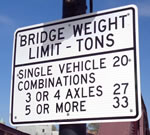An analysis of the recently-released 2014 U.S. Department of Transportation National Bridge Inventory database finds good news and bad news when it comes to the most heavily traveled U.S. bridges. While there are 2,000-plus fewer structurally deficient crossings than there were in 2013, a seemingly endless backlog of bridges needing significant repair remains.
Conducted by American Road & Transportation Builders Association Chief Economist Dr. Alison Premo Black, the U.S. DOT data analysis shows cars, trucks and school buses cross the nation’s 61,064 structurally compromised bridges 215 million times every day. Not surprisingly, the most heavily traveled are on the Interstate Highway System, which carries the bulk of truck traffic and passenger vehicles.
The bridge problem could worsen soon, Black warns. The federal Highway Trust Fund is the source of 52 percent of state governments’ annual highway and bridge capital investments. It has suffered five revenue shortfalls between 2008 and 2014, and been bailed out with nearly $65 billion from the general Treasury just to preserve existing investment levels. Nearly a dozen states have canceled or delayed road and bridge projects because of continued uncertainty surrounding the trust fund.
“State and local governments are doing the best they can to address these significant challenges, given limited resources,” Black says, noting that increased bridge investments in recent years have come the expense of highway and pavement spending, which has dropped over 20 percent since 2010.
Without additional investment from all levels of government, our infrastructure spending will be a zero-sum game,” she observes, citing a current backlog of over $115 billion in bridge work and $755 billion in highway projects, according to U.S. DOT data. “Many of the most heavily traveled bridges are nearly 50 years old. Elected officials can’t just sprinkle fairy dust on America’s bridge problem and wish it away. It will take committed investment by legislators at all levels of government.”
Bridge decks and support structures are regularly inspected by state departments of transportation for deterioration and rated on a scale of zero to nine—nine being “excellent” condition. A bridge is classified as structurally deficient and in need of repair if its overall rating is four or below. While these bridges may not be imminently unsafe, ARTBA believes that signs should be posted so the public understands they have structural deficiencies that need repair.
The National Bridge Inventory analysis also finds: The 250 most heavily crossed structurally deficient bridges are on urban interstate highways, particularly in California; nearly 87 percent were built before 1970. Pennsylvania (5,050), Iowa (5,022), Oklahoma (4,216), Missouri (3,310), Nebraska (2,654), California (2,501), Kansas (2,416), Mississippi (2,275), Illinois (2,216), and North Carolina (2,199) have the highest numbers of structurally deficient bridges. The District of Columbia (14), Nevada (34), Delaware (48), Hawaii (61), and Utah (102) have the fewest.
At least 15 percent of the bridges in eight states—Rhode Island (23 percent), Pennsylvania (22 percent), Iowa (21 percent), South Dakota (20 percent), Oklahoma (18 percent), Nebraska (17 percent), North Dakota (16 percent), and Maine (15 percent)—fall in the structurally deficient category. State-specific bridge information from the analysis—rankings and location lists of the 250 most heavily travelled structurally deficient bridges in the nation plus top five most heavily travelled in each state—is available at www.artba.org/bridges.
